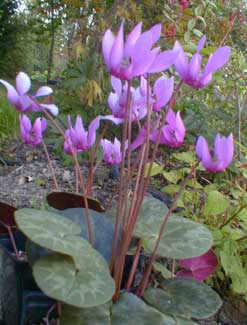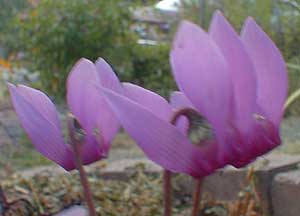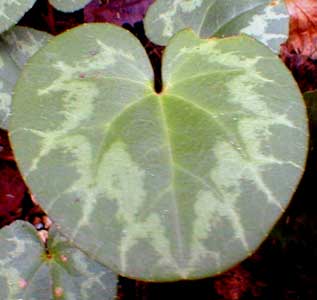
Scented European Cyclamens
"Give me odorous at sunrise
a garden of beautiful flowers
where I can walk undisturbed."
-Walt Whitman
(1819-1892)
(1819-1892)
Cyclamen purpurascens (formerly C. europeaum) is a widespread European wildflower, ranging from Switzerland through the Slavic states to Northern Italy, especially in the Alps & Carpathian Mountains.
This is the only cyclamen I'm aware of that will be evergreen so long as it does not dry out in summer. It is fully leafed while flowering, unlike many other species that flower ahead of leaf production. It sends its little flowers above the leaves from June to September, with the possibility of a few flowers up to November.
 The bloom photos here are from August (2005). Flower color can vary from plant to plant, but ours are quite a wonderful deep purply-pink with slightly darker nose. Some specimens produce muddy-magenta flowers that are not as highly prized, so it can be good idea to select them in flower to be sure of the best colors.
The bloom photos here are from August (2005). Flower color can vary from plant to plant, but ours are quite a wonderful deep purply-pink with slightly darker nose. Some specimens produce muddy-magenta flowers that are not as highly prized, so it can be good idea to select them in flower to be sure of the best colors.The flowers of this 1993 recipient of the Award of Garden Merit are wondrously scented. Although select strains of other temperate-hardy cyclamens are occasionally scented, the perfume tends to be awfully faint, & in most temperate cyclamens the perfume is simply not present. C. purpurascens is the only strongly, rebliably redolent species.
Ours grow on a raised ledge along the edge of the sunken patio, so we don't have to get on our bellies to smell them. But if enough are planted together, the scent is rich enough to carry a good distance.
Some experts recommend it for pots as it blooms better when potbound, but other specialists just as knowledgeable say this isn't so, it blooms equally well in the garden. We've found it to be an excellent bloomer in the a semi-shaded area of the garden.
 My own suspicion is that the varied reports of its easy vs moderately difficult care, its floriferousness vs minimal flowering, has less to do with being potted than with the conditions it experiences regionally. In areas where it experiences a definitive cold winter it seems to be a stronger bloomer than when grown in areas with winters that are exceedingly mild. Additionally, regular watering (not actually damp), rich soil in semi-shade, & plain dumb luck seem to be ingredients for success.
My own suspicion is that the varied reports of its easy vs moderately difficult care, its floriferousness vs minimal flowering, has less to do with being potted than with the conditions it experiences regionally. In areas where it experiences a definitive cold winter it seems to be a stronger bloomer than when grown in areas with winters that are exceedingly mild. Additionally, regular watering (not actually damp), rich soil in semi-shade, & plain dumb luck seem to be ingredients for success.Throughout its natural range it is particularly fond of growing underneath beech trees. It likes a shady location near the base of deciduous trees, requiring no more fertilizing than it gets naturally from the decay of fallen leaves. If leafmold can be prepared for it each autumn, it will do especially well.
It's not as fond of dryness as C. hederofolium can be, & should be located where it gets irrigation, for the sake of year-round moistness. In summer a thin layer of damp compost is recommendable. If it does dry out, it will not prove its evergreen potential, & may die back before it can bloom.
Leaf shape, size, & markings has quite a range. Ours have round leaves with mottled edging surrounding a green silhouette shaped like an arrow or tree, as can be seen in the October leaf portrait. Some strains have much more strikingly marked leaves, others have the pattern so faded they are nearly plain. The underside of the leaves are purple. When it is finished flowering, the leaves persist unphased by frost or light snowfall.